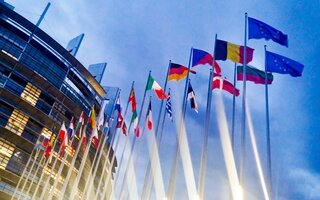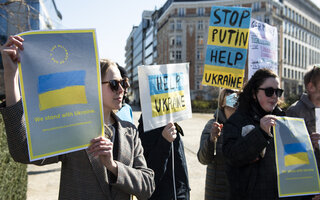Authors
Publication Date
Key Words
Related Topics
Ukraine
War
Geoeconomics
Americas
Europe
Russia
USA
Fiscal Policy & National Budgets
We study how Europe could replace US support for Ukraine both (i) financially, in terms of the fiscal effort required, and (ii) militarily, in terms of weapon production.
Financial effort:
- The financial challenge of replacing US aid is limited. Currently, European governments are spending just 0.1% of their annual GDP on bilateral aid for Ukraine - a minor effort.
- To replace US aid flows and keep total support at the same level:
- Europe needs to double its yearly support to an average level of 0.21% of GDP. This is less than half of what Denmark and the Baltics are already doing and on a level of what Poland and the Netherlands do. In short: Europe as a whole would need to follow Scandinavia’s or Poland’s example.
- In absolute terms (billions of Euro), the biggest European countries and the EU Institutions will be decisive. To replace US aid and get to 0.21% of GDP, Europe as a whole needs to increase its yearly aid flow from currently €44 bn per year to €82 bn per year.
- The biggest donors for that effort will be the EU institutions (Commission and EIB), who will need to increase their annual support from currently €16 bn to €36 bn per year. Next comes Germany (from currently €6 billion to at least €9 billion per year), then Great Britain (from €5 to €6.5 bn per year), then France (from currently just €1.5 bn to €6 bn per year), Italy (from currently just €0.8 bn to €4.5 bn) and Spain (from just €0.5 bn to €3 bn per year). All remaining European donors would need to move from €14 bn to €16.5 bn per year.
- To avoid freeriding, we recommend offering financial incentives to those countries giving aid to Ukraine. Big Ukrainian donors (in % of GDP) could get priority access to any new EU-level defense financing scheme. Large Ukraine aid could also be exempt from EU fiscal rules, or deducted from each nation’s contributions to the EU budget.
Military effort:
- On military aid, replacing the US will be more challenging, but is possible in many domains. We show weapon-by-weapon that Europe’s industry has viable alternatives for almost all of the main US heavy weapon systems donated to Ukraine. Europe also accelerated ammunition production and this effort would now need to be intensified at greater speed and scale, especially for howitzer ammunition.
- Our data show that the biggest dependency from US-produced weapons is in (i) rocket artillery such as HIMARS (86% of weapons for Ukraine are US-produced systems), (ii) Howitzer ammunition (82% US produced), (iii) long-range anti-aircraft systems such as Patriots (70% US produced). In other domains, European weapons play a more important role, in particular regarding Howitzers and battle tanks.
- Among the heavy weapons, US HIMARS and Patriots are hardest to replace, as is the supply of ammunition for these systems. Also, US intelligence sharing and satellite imagery are decisive.
- To respond to these challenges:
- Europe needs to ramp up the production of essential weapons and artillery ammunition quickly and broadly. It is advantageous that European donors already transited away from donating from stocks to procuring new weapons for Ukraine from industry. These procurement efforts would need to be extended considerably by making firm medium- and long-term commitments to weapon-producing firms.
- For US weapons that are hard to replace, Europe could place orders in the US and beyond. Viable alternatives to HIMARS include the South Korean K239 Chunmoo and Israel’s PULS. In addition, Europe could heavily invest in the development and production of alternative systems such as SAMP/T.
- European countries could also increase drone production considerably, both by European producers, and, more importantly, by directly investing in the highly successful weapons industry of Ukraine.
- Finally, Europe would need to move fast to build alternative digital, satellite, and intelligence systems, including accelerated and expanded initiatives such as the satellite internet constellation IRIS2.








